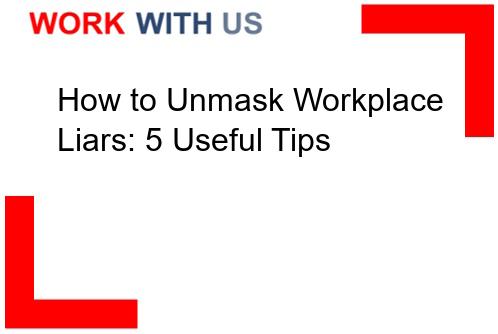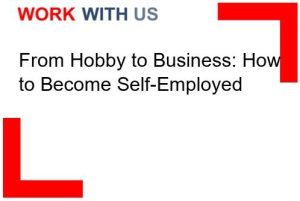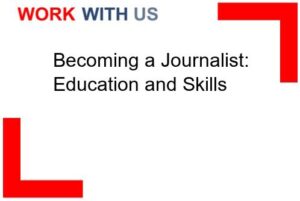In today’s competitive and fast-paced work environment, it is not uncommon to encounter individuals who resort to dishonesty and deception to gain an advantage. Workplace liars can create a toxic atmosphere, erode trust, and hinder productivity. Identifying and unmasking these individuals is crucial for maintaining a healthy and transparent work culture. With that in mind, this article will provide five useful tips on how to unmask workplace liars, enabling you to navigate these challenging situations with confidence and integrity.
Firstly, it is essential to pay close attention to inconsistencies in an individual’s statements or behavior. Liars often struggle to maintain a consistent narrative, leading to contradictions and discrepancies in their stories. By actively listening and observing, one can identify these inconsistencies and confront the liar with specific examples. This approach not only exposes their dishonesty but also demonstrates that their actions are being closely monitored.
Secondly, body language can be a powerful indicator of deception. Non-verbal cues such as fidgeting, avoiding eye contact, or excessive sweating can suggest that someone is being untruthful. Additionally, defensive postures, such as crossed arms or a closed-off stance, may indicate that the individual is trying to hide something. By being attentive to these signals, one can gain valuable insights into a person’s honesty and integrity.
Thirdly, building a network of trustworthy colleagues can be instrumental in unmasking workplace liars. By fostering open and honest communication within the team, individuals are more likely to share their experiences and observations. This collective knowledge can help identify patterns of dishonesty and expose habitual liars. Encouraging a culture of transparency and accountability will not only deter dishonest behavior but also create a supportive environment where truth prevails.
Fourthly, conducting thorough background checks and verifying credentials can help uncover workplace liars before they even enter the organization. By diligently checking references, educational qualifications, and employment history, employers can minimize the risk of hiring individuals with a history of dishonesty. Additionally, implementing rigorous interview processes that include behavioral questions can help assess a candidate’s honesty and integrity.
Lastly, it is crucial to trust your instincts when dealing with potential workplace liars. Intuition can be a powerful tool in identifying individuals who may not be entirely truthful. If something feels off or inconsistent, it is essential to investigate further and gather evidence before making any accusations. However, it is important to strike a balance between trusting your instincts and relying on concrete evidence to avoid false accusations or unfair judgments.
In conclusion, unmasking workplace liars is essential for maintaining a healthy and productive work environment. By paying attention to inconsistencies, observing body language, building a network of trustworthy colleagues, conducting thorough background checks, and trusting your instincts, individuals can effectively identify and confront dishonest individuals. By promoting a culture of transparency and accountability, organizations can foster an atmosphere of trust and integrity, ensuring the success and well-being of their employees.
Understanding the psychology of workplace liars: key insights for detection
In today’s fast-paced and competitive corporate world, the prevalence of workplace liars has become a pressing concern for organizations. These individuals, driven by various motives, engage in deceptive behaviors that can have detrimental effects on productivity, trust, and overall morale. To effectively combat this issue, it is crucial for employers and colleagues alike to gain a deeper understanding of the psychology behind workplace liars.
One key insight into the psychology of workplace liars is the underlying motivation that drives their deceptive behavior. While each individual may have unique reasons, common motives often include personal gain, fear of consequences, or the desire to maintain a certain image. By recognizing these motivations, employers can implement strategies to address them proactively.
Another important aspect to consider is the mindset of workplace liars. Research suggests that these individuals often possess a heightened sense of entitlement and a lack of empathy towards others. They may rationalize their deceptive actions by believing that they are justified or necessary for their own success. Understanding this mindset can help employers identify potential liars and take appropriate measures to prevent their harmful behavior.
Furthermore, it is essential to recognize the behavioral patterns exhibited by workplace liars. These individuals often display signs of deceit, such as avoiding eye contact, providing vague or inconsistent information, or becoming defensive when questioned. By observing these behavioral cues, colleagues and supervisors can become more adept at detecting potential lies and addressing them promptly.
Additionally, the impact of workplace liars on organizational dynamics cannot be underestimated. Their deceptive actions erode trust among team members, leading to a toxic work environment. This, in turn, can hinder collaboration, communication, and overall productivity. Recognizing the detrimental effects of workplace liars underscores the importance of implementing effective detection strategies.
One such strategy is the utilization of behavioral interviewing techniques during the hiring process. By asking open-ended questions and carefully observing candidates’ responses and body language, employers can gain valuable insights into their truthfulness and integrity. Additionally, conducting thorough background checks and verifying references can help identify any discrepancies or red flags.
Moreover, fostering a culture of open communication and transparency within the workplace can act as a deterrent for potential liars. When employees feel comfortable expressing their concerns or reporting suspicious behavior, it becomes more difficult for workplace liars to operate undetected. Encouraging regular feedback sessions, implementing anonymous reporting systems, and providing training on ethical conduct can all contribute to creating a more honest and trustworthy work environment.
Furthermore, it is crucial for employers to address the root causes that may drive individuals to engage in deceptive behavior. This can involve providing adequate support and resources to employees, promoting a healthy work-life balance, and fostering a positive organizational culture. By addressing these underlying factors, employers can reduce the likelihood of individuals resorting to deceitful practices.
In conclusion, understanding the psychology of workplace liars is essential for effective detection and prevention. By recognizing their motivations, mindset, and behavioral patterns, employers and colleagues can become more adept at identifying potential liars and taking appropriate measures. Creating a culture of open communication, implementing thorough hiring processes, and addressing underlying causes can all contribute to mitigating the detrimental effects of workplace liars. Ultimately, by prioritizing honesty and integrity, organizations can foster a healthier and more productive work environment.
Nonverbal cues and microexpressions: unveiling deception in the workplace
Nonverbal cues and microexpressions play a crucial role in deciphering deception in the workplace. While verbal communication is important, it is often the nonverbal signals that provide valuable insights into a person’s true intentions and emotions. Understanding these cues can help employers and colleagues identify potential deception, improve communication, and foster a more transparent and trustworthy work environment.
Nonverbal cues
encompass a wide range of behaviors, including facial expressions, body language, gestures, and tone of voice. These cues can be subtle and fleeting, making them challenging to detect. However, with careful observation and analysis, one can uncover hidden meanings and uncover deception.
Facial expressions
are one of the most significant nonverbal cues. Microexpressions, which are brief facial expressions that occur involuntarily, can reveal a person’s true emotions. For example, a fleeting expression of fear or surprise when discussing a particular topic may indicate deception or discomfort. Similarly, a forced smile or a raised eyebrow can hint at insincerity or disagreement.
Body language
is another crucial aspect of nonverbal communication. Posture, gestures, and movements can provide valuable insights into a person’s thoughts and feelings. For instance, crossed arms and a defensive posture may indicate resistance or discomfort. On the other hand, open and relaxed body language can signify honesty and openness.
Tone of voice
is often overlooked but can be a powerful indicator of deception. Changes in pitch, volume, and speech rate can reveal underlying emotions and intentions. A sudden shift in tone or a hesitant voice may suggest that someone is withholding information or being untruthful.
While nonverbal cues can be indicative of deception, it is essential to consider
context
. Cultural differences, individual personality traits, and situational factors can influence nonverbal behavior. What may be interpreted as deception in one culture could be a normal expression in another. Therefore, it is crucial to consider these factors when analyzing nonverbal cues in the workplace.
Building trust
is vital in any work environment, and understanding nonverbal cues can help foster trust among colleagues. By paying attention to these cues, individuals can establish more meaningful connections and develop stronger professional relationships. When colleagues feel understood and valued, they are more likely to be open and honest, leading to improved collaboration and productivity.
Effective communication
is another area where nonverbal cues play a significant role. By being aware of nonverbal signals, individuals can better interpret the true meaning behind a message. For example, a person’s body language may contradict their verbal statement, indicating a lack of conviction or sincerity. By addressing these inconsistencies, misunderstandings can be avoided, and communication can be more effective.
Conflict resolution
can also benefit from an understanding of nonverbal cues. During tense situations, individuals may display defensive or aggressive body language, hindering the resolution process. By recognizing these cues, conflicts can be de-escalated, and a more constructive dialogue can take place. Additionally, nonverbal cues can help identify underlying emotions, allowing for empathy and understanding during conflict resolution.
Leadership
is another area where nonverbal cues are crucial. Effective leaders are skilled at reading and interpreting nonverbal signals, allowing them to understand the needs and concerns of their team members. By being attuned to these cues, leaders can adapt their communication style, provide support, and motivate their team effectively.
In conclusion, nonverbal cues and microexpressions are powerful tools for unveiling deception in the workplace. By understanding and interpreting these cues, employers and colleagues can identify potential deception, improve communication, and foster trust and transparency. Nonverbal cues provide valuable insights into a person’s true emotions and intentions, allowing for more effective communication, conflict resolution, and leadership. Developing the ability to read and interpret nonverbal cues is a valuable skill that can greatly enhance interpersonal relationships and overall workplace dynamics.
Building a culture of trust: strategies to deter workplace deception
Creating a Culture of Trust: Effective Strategies to Combat Workplace Deception
In today’s competitive business landscape, building a culture of trust within an organization is crucial for fostering a positive work environment and driving success. Trust forms the foundation of strong relationships, enhances collaboration, and boosts employee morale. However, workplace deception can erode trust, leading to decreased productivity, increased turnover, and a toxic work atmosphere. To combat this issue, organizations must implement effective strategies to deter workplace deception and cultivate a culture of trust.
One key strategy is to establish clear and transparent communication channels. When employees feel that their voices are heard and their opinions matter, they are less likely to engage in deceptive behaviors. Encouraging open dialogue and providing platforms for employees to express their concerns or suggestions can help foster trust and prevent deception from taking root.
Another effective approach is to lead by example. Leaders play a pivotal role in shaping the culture of an organization. By demonstrating honesty, integrity, and ethical behavior, leaders set the tone for the entire workforce. When employees witness their leaders acting with transparency and fairness, they are more likely to follow suit, creating a culture of trust that permeates throughout the organization.
Implementing robust hiring and screening processes is also crucial in deterring workplace deception. Organizations should conduct thorough background checks, verify credentials, and assess candidates’ integrity during the recruitment process. By hiring individuals with a track record of honesty and ethical behavior, organizations can minimize the risk of deception within their workforce.
Regular training and education programs can also help combat workplace deception. By providing employees with the necessary knowledge and skills to identify and address deceptive behaviors, organizations empower their workforce to act as a collective defense against deception. Training sessions can cover topics such as ethical decision-making, recognizing red flags, and reporting suspicious activities. By equipping employees with the tools to navigate ethical dilemmas, organizations can foster a culture of trust and integrity.
Establishing a strong whistleblower protection program is another essential strategy. Employees should feel safe and supported when reporting instances of deception or unethical behavior. Implementing a confidential reporting system, protecting whistleblowers from retaliation, and conducting thorough investigations into reported incidents are crucial steps in building trust and deterring workplace deception.
Promoting a positive work-life balance is also vital in preventing workplace deception. When employees are overworked, stressed, or feel undervalued, they may be more susceptible to engaging in deceptive behaviors. Organizations should encourage employees to take breaks, prioritize self-care, and maintain a healthy work-life balance. By fostering a supportive and nurturing environment, organizations can reduce the likelihood of deception and promote trust among employees.
Regular performance evaluations and feedback sessions can also contribute to building a culture of trust. By providing constructive feedback and recognizing employees’ achievements, organizations demonstrate their commitment to fairness and transparency. When employees feel valued and acknowledged for their contributions, they are less likely to resort to deceptive practices to gain recognition or advancement.
Lastly, organizations should establish a strong code of conduct and enforce it consistently. A well-defined code of conduct outlines the expected behaviors and ethical standards within the organization. By clearly communicating these expectations and holding employees accountable for their actions, organizations can deter workplace deception and foster a culture of trust and integrity.
In conclusion, building a culture of trust is essential for organizations to thrive in today’s competitive business landscape. By implementing strategies such as transparent communication, leading by example, robust hiring processes, training programs, whistleblower protection, promoting work-life balance, providing regular feedback, and enforcing a strong code of conduct, organizations can effectively deter workplace deception. By cultivating an environment built on trust, organizations can foster collaboration, enhance productivity, and create a positive work atmosphere that attracts and retains top talent.
Effective communication techniques: enhancing truthfulness and reducing deception
Effective communication techniques play a crucial role in enhancing truthfulness and reducing deception in various interpersonal interactions. Whether it is in personal relationships, professional settings, or even public discourse, the ability to communicate effectively can foster trust, transparency, and understanding. This article explores some key strategies that can be employed to promote honest and open communication, while also delving into related topics that shed light on the intricacies of human interaction.
Building Trust and Rapport
One of the fundamental aspects of effective communication is building trust and rapport with the other person. Trust forms the foundation of any relationship, and without it, communication can be hindered by skepticism and doubt. To establish trust, individuals should strive to be honest, reliable, and consistent in their words and actions. This means being truthful even when it may be uncomfortable or inconvenient. By consistently demonstrating integrity, individuals can create an environment where open and honest communication is encouraged.
Active Listening
Active listening is another crucial technique that enhances truthfulness in communication. It involves fully engaging with the speaker, paying attention to both verbal and non-verbal cues, and demonstrating genuine interest in what the other person is saying. Active listening requires setting aside distractions, maintaining eye contact, and providing verbal and non-verbal feedback to show understanding and empathy. By actively listening, individuals can create a safe space for others to express themselves honestly, reducing the likelihood of deception.
Non-Verbal Communication
Non-verbal communication plays a significant role in conveying truthfulness. Facial expressions, body language, and tone of voice can often reveal more about a person’s true feelings and intentions than their words alone. Being aware of one’s own non-verbal cues and interpreting those of others can help in understanding the underlying message being communicated. For instance, crossed arms and a defensive posture may indicate discomfort or disagreement, while open body language and a warm smile can signal receptiveness and honesty.
Emotional Intelligence
Emotional intelligence is the ability to recognize, understand, and manage one’s own emotions, as well as those of others. It plays a vital role in effective communication by allowing individuals to navigate sensitive topics and difficult conversations with empathy and tact. By being aware of their own emotions and managing them appropriately, individuals can prevent emotional reactions that may hinder truthful communication. Additionally, understanding the emotions of others enables individuals to respond in a way that promotes understanding and trust.
Cultural Sensitivity
Cultural sensitivity is essential in promoting truthful communication, particularly in diverse and multicultural settings. Different cultures have varying communication styles, norms, and values, which can influence how truthfulness is expressed and perceived. Being sensitive to these cultural differences helps individuals avoid misunderstandings and misinterpretations. It also demonstrates respect for others’ perspectives and fosters an inclusive environment where diverse voices are valued.
The Power of Language
Language is a powerful tool that can either enhance or hinder truthful communication. The choice of words, tone, and clarity of expression can significantly impact how a message is received. Using clear and concise language, avoiding jargon or technical terms when unnecessary, and adapting the communication style to the audience can help ensure that the intended message is accurately conveyed. Additionally, individuals should be mindful of the potential for misinterpretation and strive to clarify any ambiguities to prevent misunderstandings.
The Role of Empathy
Empathy is the ability to understand and share the feelings of another person. It plays a crucial role in effective communication by allowing individuals to connect on a deeper level and foster understanding. By putting themselves in the shoes of others, individuals can better grasp their perspectives, motivations, and emotions. This understanding enables them to communicate in a way that acknowledges and respects the other person’s experiences, reducing the likelihood of deception and promoting truthfulness.
Overcoming Barriers to Truthful Communication
Despite employing various techniques to enhance truthfulness in communication, there are still barriers that can impede honest and open dialogue. These barriers include fear of judgment or reprisal, cultural or societal norms that discourage honesty, and personal biases or prejudices. Overcoming these barriers requires creating a safe and non-judgmental environment, promoting a culture of transparency and accountability, and challenging one’s own biases and assumptions.
Effective communication techniques are essential in enhancing truthfulness and reducing deception in interpersonal interactions. Building trust and rapport, active listening, non-verbal communication, emotional intelligence, cultural sensitivity, language choice, empathy, and overcoming barriers are all key strategies that can contribute to fostering honest and open communication. By employing these techniques, individuals can create an environment where truthfulness is valued, leading to stronger relationships, increased understanding, and more meaningful connections.



